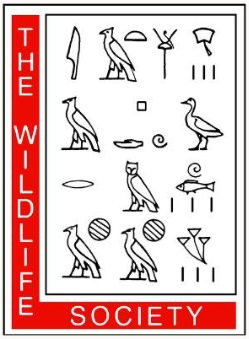Wildlife
Conservation, ecology, and management of wild animal populations.
Members of The Wildlife Society's (TWS) College and University Education Working Group created a Learning Framework for Wildlife, which outlines the competencies that students majoring in wildlife should achieve by the time they graduate.
The following people worked to develop this TWS approved Wildlife Learning Framework: Elizabeth Flaherty (Purdue University), Lara Pacifici (North Carolina State University), Larkin Powell (University of Nebraska - Lincoln), Tracy Rittenhouse (University of Connecticut).
Download the Wildlife Learning Framework
The Wildlife Society
Founded in 1937, the organization’s mission is “To inspire, empower, and enable wildlife professionals to sustain wildlife populations and habitats through science-based management and conservation.” The Wildlife Society enhances members’ networking and learning opportunities, professional and career development, and provides numerous ways for them to get more involved in creating a better future for wildlife and their habitats.
Course Editor(s):
Wildlife Learning Framework
Society Learning Goals
Articles
Wildlife Population Management
Animal ID: What traits and characteristics are diagnostic in identifying insects, amphibians, reptiles, birds, and mammals?
Sample Learning Objectives- Identify animal species of the student’s local region.
Animal ecology: How do species interact with each other and their environment?
Sample Learning Objectives- Describe how competition and predation impact wildlife populations.
- Defend the inclusion of community ecology concepts when managing a wildlife population.
- Explain the influence of animal behavior on species interactions and population management.
- Explain predator prey dynamics.
Population management: How does setting harvest limits differ when using a maximum sustain yield model compared to an annual surplus model?
Sample Learning Objectives- Describe the critical steps in the adaptive harvest management process.
- Evaluate the need for adaptive management in harvest management.
Declining or endangered populations: When habitat loss is not the cause of a population decline, what are other causes of decline to consider and how would management actions differ based on the cause of decline?
Sample Learning Objectives- Explain how genetic drift and inbreeding dynamics contribute to the extinction vortex.
- Describe how a population viability model can be used to select management goals for species of conservation concern.
- Analyze the connection between invasive species and threatened species.
Disease ecology and wildlife health: What actions can wildlife managers take to monitor and combat epidemics in wildlife populations and protect human health?
Sample Learning Objectives- Incorporate a decontamination protocol into a standard field sampling protocol and into a response to mortality event.
- Describe when an epidemic in a wildlife population is a concern to human health.
Movement and habitat selection: How do animals select habitat when moving through their home range or territory? What field and analytical methods work best given a specific species or context?
Sample Learning Objectives- Compare the specificity and effectiveness of trapping methods within a range of habitat types.
- Compare home range estimation techniques.
Habitat Management
Plant ID: What traits and characteristics are diagnostic in identifying grasses, forbs, shrubs, and trees?
Sample Learning Objectives- Compare the differences between grasses, forbs, shrubs, and trees.
- Evaluate vegetation communities and recommend management strategies to maintain or improve habitat conditions for target wildlife.
Plant ecology and succession: How do plant communities transform through succession from pioneer species to climax communities in different ecosystems?
Sample Learning Objectives- Describe the different stages of succession and detail the species present at each stage in a given ecosystem.
- Evaluate vegetation communities and recommend management strategies to maintain or improve habitat conditions for target wildlife.
Habitat requirements: What are the habitat requirements for different wildlife species?
Sample Learning Objectives- Describe the potential wildlife community given habitat characteristics in an ecosystem.
- Compare the habitat requirements for several wildlife species in a given ecosystem.
Habitat manipulation tools: How are tools and techniques used to manage land for wildlife habitat?
Sample Learning Objectives- Explain the tools and techniques used to remove invasive plant species from a forest ecosystem.
- Evaluate the efficacy of prescribed fire in management of a given tract of land in relation to the management goals for that land.
- Conduct a habitat suitability survey using the appropriate tools and techniques for a given area and species.
Landscape management: What are the direct and indirect influences of land management on wildlife habitat?
Sample Learning Objectives- Assess vegetation communities and recommend management strategies to maintain or improve habitat conditions for target wildlife.
- Appraise the effects of human actions such as development or agriculture on components of habitat for target species.
Soils, geology, hydrology: How does soil composition, geology, and hydrology influence wildlife habitat?
Sample Learning Objectives- Explain how different soil types affect suitability of habitat for different wildlife species.
- Examine the differences in biodiversity in areas with differences in the nature of the underlying rock.
- Compare the available habitat features in areas with different types of hydrological features.
People and Wildlife
Policy: How does policy affect management of wildlife populations and related natural resources?
Sample Learning Objectives- Describe how planning processes of state and federal agencies result in unique policies for each agency.
- Contrast how key environmental laws and policy affect wildlife on public and private lands.
- Provide an opinion of the adequacy of current policy processes that affect wildlife on public and private lands in the US?
Human dimensions: How are social sciences used in effective management of wildlife?
Sample Learning Objectives- Explain how the experiences of individuals influence their beliefs and values.
- Recommend ways that wildlife managers can influence behaviors of the public on matters of conservation based on understanding of the importance of individual’s beliefs and values.
Laws and regulations: How are laws and regulations for wildlife enacted, and how do they impact management of wildlife and related natural resources?
Sample Learning Objectives- Explain the process that is used to set harvest regulations for game animals.
- Examine the potential flaws in the system for listing species under the Endangered Species Act?
- Connect NEPA to other federal and state laws that influence fish and wildlife management in the US?
- Outline the history of wildlife management.
Communication: How can wildlife management be enhanced by implementing effective communication strategies?
Sample Learning Objectives- Prioritize ways that wildlife managers can effectively incorporate stakeholders in the management process.
- Describe the structure of a wildlife management plan.
- Explain how a wildlife management plan is used to communicate to stakeholders.
- Evaluate an oral presentation used to communicate to scientific and public audiences.
Conflict resolution: How do we resolve conflicts between important stakeholder groups on issues related to wildlife management?
Sample Learning Objectives- Explain the steps followed by wildlife professionals to resolve conflicts in underlying objectives of stakeholders.
Structured decision making: How can we make better decisions for management of wildlife and habitats and people?
Sample Learning Objectives- Explain the steps in the formal "PROACT" structured decision process.
- Develop a management plan using the structured decision process.
- Suggest how the value of diverse stakeholders can be incorporated in the decision-making process for wildlife management.
Quantitative Skills
GIS: How can spatial data be displayed and analyzed in a geographic information system?
Sample Learning Objectives- Compare the advantages that vector and raster data convey to spatial data analyses.
- Describe the dynamics that affect precision of estimates of location from global positioning systems.
- Rank the importance of basic tools used in geographic information systems for spatial inquiries for wildlife species and habitats.
- Contrast the key tradeoffs among the main types of projections used to display spatial data in a geographic information system.
Statistics: How can we draw inference from data regarding a research question?
Sample Learning Objectives- Compare the assumptions of various statistical models that are useful in the analysis of ecological data.
- Describe statistical theories for methods of analysis for ecological data.
- Choose an appropriate statistical method for a given data set and research question.
- Show how statistical methods provide inference needed to make decisions.
Experimental design: How can we design an ecological experiment to guide management?
Sample Learning Objectives- Show how the scientific method is incorporated into the process of experimental design.
- Discuss how experimentation and design are reflected in the process of adaptive resource management.
- Explain the key statistical concepts that are reflected in a robust experimental design.
- Justify the modifications needed for experimentation in field ecology.
Population modeling: How can we predict the size and structure of populations in the future?
Sample Learning Objectives- Contrast the types of models used to predict population size under different management scenarios.
- Describe how the effects of harvest and uncertainty are incorporated into population models used to assess differences in proposed harvest management regulations.
- Explain the outputs of a population viability model constructed for species of conservation concern.
Population estimation: How do we estimate the size of populations and other demographic parameters such as survival?
Sample Learning Objectives- Defend the use of indices for management of populations.
- Justify the reasons for the assumptions of estimation models for estimation of population size and survival.
- Describe how incomplete detectability influences the estimation of population size and/or density from survey data or mark-recapture data.
- Compare how estimation of survival differs from mark-release-recapture and radio-telemetry data.
Leadership and Professionalism
Professional interactions: How do we combine and engage conflict management, leadership, and teamwork skills to achieve a group goal?
Sample Learning Objectives- Understand how personal traits can impact you and other people when working in a team setting.
- Differentiate among behaviors or strategies that support positive interactions with other wildlife professionals.
- Implement behaviors or strategies to complete a group task or project.
- Develop strategies to achieve a common goal.
- Develop and practice written and oral communication for collaboration, outreach, and education.
Professional ethics: How do we apply professional ethics and standards to wildlife work?
Sample Learning Objectives- Incorporate ethical measures into project or research study design.
- Identify negative outcomes for incorrect application or neglecting ethics in professional wildlife work.
- Differentiate between ethical and legal requirements/policies.
Diversity, equity, and inclusion: How do we prioritize and improve diversity, equity, inclusion, and belonging in the wildlife profession?
Sample Learning Objectives- Define diversity, equity, and inclusion (DEI).
- Identify the importance and benefits of DEI in professional wildlife work.
- Develop self-awareness to address bias and support diversity.
- Analyze the role of institutions and culture within the wildlife field that create inequality among students and professionals.

